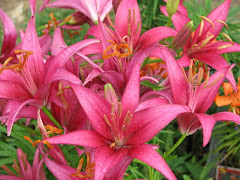
I have all these little tags laying around that came in plants I have bought, so I'm going to make a list of them so I can throw them away. I found one in my tea drawer this morning!
Lavender Cotton - Santolina pinnata - subsp. neapolitana - planted in herb garden June 2008, 2 plants
Chives - 4 small plants, herb garden June 2008
Yarrow - Achillea Millefolium "Cerise Queen", 1 plant in herb garden June 2008
Golden Oregano - 1 plant, herb garden June 2008
Summer Savory - Satureja hortensis, 1 plant in herb garden June 2008 - I thought it was an annual, but it came back this year.
Lamb's Ear - Stachys byzantina - 3 plants in herb garden 2008
Greek Oregano - 1 plants in herb garden June 2008
Silver-edged Thyme - Thymus 'Argenteus' - 1 plant in herb garden June 2008
Prairie Splendor Coneflower - Echinacea purpurea 'Prairie Splendor' - 1 plant in herb garden June 2008
Ruby Star Coneflower - Echinacea purpurea 'Rubinstern' - 1 plant in herb garden June 2008 (I thought I had two of the same type of coneflower. I just now found out otherwise. I'm really on top of things in my garden, huh.)
Wall Germander - Teucrium chamaedrys" - 17 plants in herb garden June 2008 - bought from Mountain Valley Growers
Rose - Flower Carpet 'Scarlet'
One Lemon Balm plant
One Oriental Poppy plant
Two Anise Hyssop plants, can't find the tag; it will probably turn up in some strange place when I'm not looking for it.
All of these were planted in a mad dash last year right before I had surgery. Also in the herb garden are two viburnum bushes, otherwise known as snowball bushes; a David Austin rose 'Mary Rose', and a miniature rose whose name I can't remember.
Tiny Ghost Asiatic Lily - Lilium asiaticum 'Tiny Ghost' PP16161 - 8 plants in two bed beside wisteria tree, planted summer 2008.
Sage plants I have killed: Golden Sage, Tricolor Sage (2), Common Sage.
This year I planted a Mandevilla 'Alice duPont' in the spot where the sage plants are supposed to be in the herb garden. Apparently, this location is cursed as the Mandevilla never has more than one bloom to its name and looks like it is barely hanging on to life.
Stonecrop - Sedum spectabile 'Neon' - planted this year in the back between the rose and crepe myrtles.
Salvia - 'Red Hot Sally' - 8 plants this summer; when we came back from Vancouver they had disappears entirely. I think the rabbit ate them.
Begonia 'Bronze Leaf Rose' - 4 plants in a pot out front this summer.
Evolvulus - 3 plants in a pot in from this summer. I love these pots; we got them a few years ago at the Dallas Farmers Market.
One pot on the front porch - 2 Trailing verbena (it isn't trailing, but instead growing straight up; makes the pot look a little silly), 4 vincas, and 2 coleus plants.
















































































